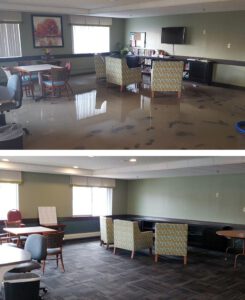In floods, it is imperative to take steps to mitigate the damages caused by the water. The presence of water in a home can lead to many issues, including mold and bacteria growth, rotting of wood, rusting of steel, swelling of composite woods, and delamination of materials. To avoid these problems, you must take steps to mitigate water damage. These steps will help you avoid costly restoration costs and restore your home as quickly as possible.
The first step in Water Damage Mitigation is to determine the source of the water. Once the source of the water is identified, it will be easier to clean up damaged and submerged items. Make sure to keep all parts of your belongings, including furniture, for inspection by your insurance company. Make sure to turn off circuit breakers in any wet areas, unplug any electrical appliances, and take measures to protect small furniture items from stains. Aluminum foil placed under wooden furniture legs will help protect them from stains.
The process of water mitigation will vary depending on the type of property and the type of damage. However, some steps remain the same. Use them as a checklist and work out the steps that you need to take. The first step in water mitigation is assessing the damage. It is imperative to protect any valuables and to assess the safety of the household. Water damage can cause structural, electrical, and even medical issues, so it is essential to mitigate the damage immediately.
Depending on the severity of the water damage, the mitigation process may involve tarping off affected areas, salvaging contents, and restoring the structure’s structural integrity. Water mitigation also involves removing the water to prevent it from spreading and causing additional damage. This is usually done with the help of a commercial-grade truck-mounted extractor. A portable extractor is another option. Finally, a restoration process restores the structure back to its pre-loss condition.
To mitigate water damage, you need to find a company with certification. The Restoration Industry Association and the Water Loss Institute are two trade associations that publish industry-accepted standards. Certified companies are able to work with any type of damage because they are trained in the latest technologies and techniques. And they also have the necessary equipment and protocols to detect hidden damage. A certified company can handle any type of water damage and will help you prevent costly restoration mistakes.
A properly installed leak detection system is critical to water damage mitigation. Even a small crack in a pipe can release the equivalent of a 50-gallon water heater in six minutes. If a leaky pipe is not detected quickly, water mitigation experts can use powerful equipment to dry the property, such as industrial dehumidifiers, sub-floor drying systems, and high-speed fans. This equipment will reduce the moisture levels in the building so that it does not cause further damage.
There are three main types of water damage. Firstly, grey water, which is wastewater that is not clear, is classified as Category 1. Then there is Category 2 gray water, which includes sewer backups, ruptured disposal lines, and leaking washing machine hoses. Lastly, there is black water, which is a far more difficult category to mitigate. This water contains hazardous chemicals and pathogens. If you suspect a home is suffering from this, you should contact a certified company immediately.
While it is tempting to tackle the problem yourself, the most effective way to protect your home from water damage is to hire a professional water mitigation company to do the work for you. Hiring a water mitigation company can save you hundreds of dollars in repairs. Professionals also know how to work with insurance companies and calculate the damage. A water mitigation company will also help you file a claim. It is essential to understand the importance of water damage mitigation for your home or business.
Getting rid of the standing water as soon as possible is vital. The removal of standing water can make the rest of the process much easier. By removing the water as quickly as possible, you can minimize the chance of mold and bacteria growth. A professional team will also work with you to determine the best course of action. For homeowners, this can mean the difference between a home being inhabitable and being destroyed. So, if your home or business is experiencing water damage, it is essential to call a professional as soon as possible.
If you’ve been forced to deal with a flood, you can choose to disclose the damages in order to keep the potential buyers interested. While a small amount of water damage is okay for your home, it isn’t desirable for your property. That’s why you should make sure potential buyers know about it and take appropriate action. If you don’t, it will only scare away potential buyers and ruin your sale.
